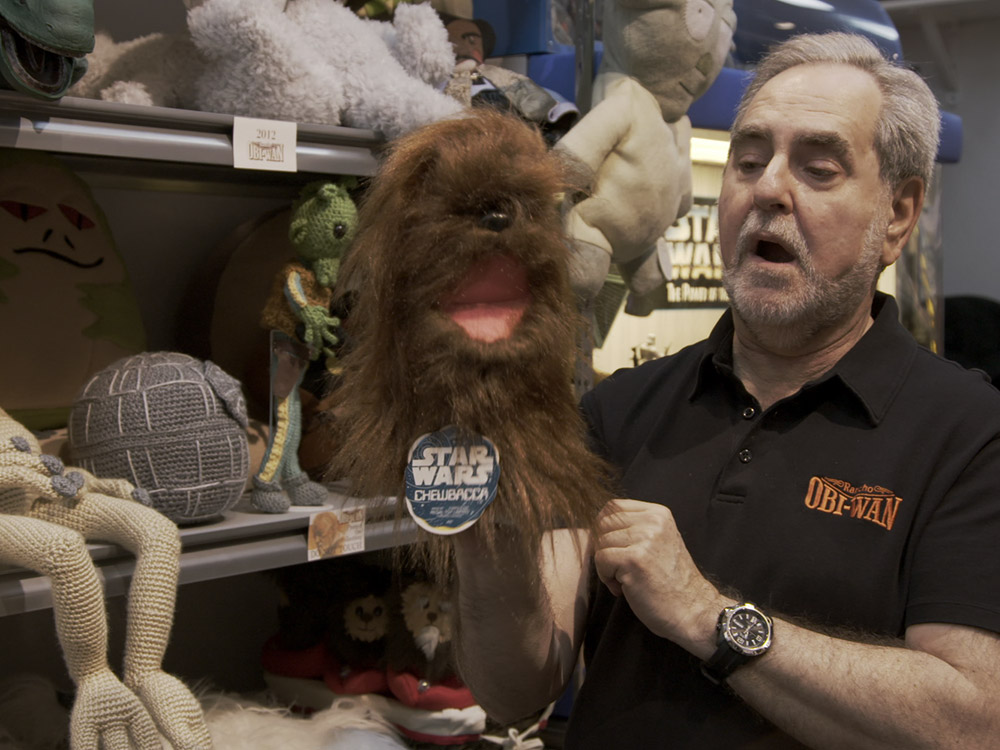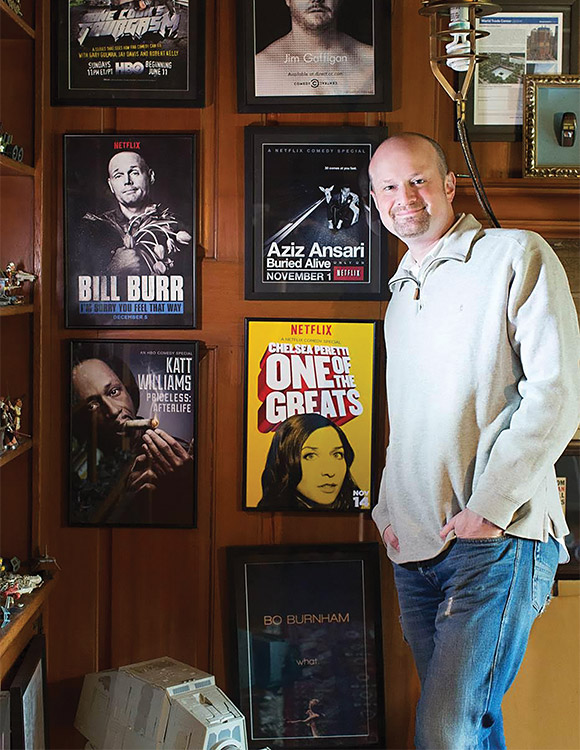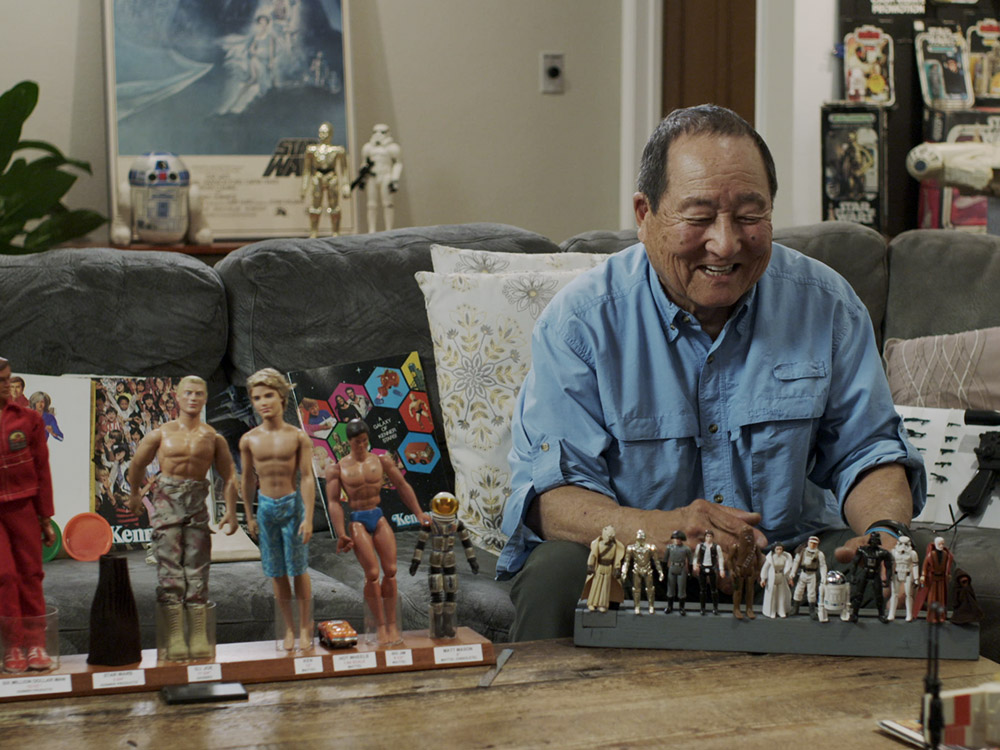Brian Volk-Weiss, a toy collector with more than 700 pieces of his own, turned his passion project into the Netflix series The Toys That Made Us. The Pop Insider‘s Ali Mierzejewski spoke with him about making the show, and how his career as a comedy producer helped him get the partnership he needed for this show to thrive.
Pop Insider: Did the idea for the show come out of your love for toys? Is it a passion project?
Brian Volk-Weiss: I was working on this toy show long before Netflix was even making original content, so it took about seven years to actually sell it. I came very close twice and, in retrospect, I’m very lucky that I didn’t sell to where it would’ve sold then.
The Eureka moment was when I was in a bookstore, and for whatever reason, I wanted to learn more about Transformers and the origin of Transformers. And I found it very hard—there were literally no books about the origin of the Transformers. Then, I realized there were no books about the origin of G.I. Joe. There were a bunch of books about Star Wars toys, but they were always about the toys; they were never about “why were they three and three-quarters… why this? Why that?”
But at the same time, when I was in the bookstore I noticed that there were so many books about the War of 1812, which very few people know about, and it inspired very few people who are alive today.
Transformers, G.I. Joe, Barbie, and all these toys inspired so many people, but you can’t find out anything about them? So that was the Eureka moment when I realized that there was a hole that should be filled. Even if people don’t collect toys, 99.9 percent of us played with toys, so I’m sure they would find it interesting to learn more about the things they played with, but never thought about when they were little kids.
PI: You tried to sell this show before, but it eventually landed at Netflix. What are the benefits of working with Netflix?
BVW: There are a bunch of benefits.
The first benefit—which since Toys happened to me a few times, but before Toys never happened to me before—is there was no pilot. They literally went straight to eight episodes, so that’s like breathing underwater without wearing scuba gear. It’s like, “this is impossible”—that’s what that felt like when it happened.
Second of all, one of the things that’s great about Netflix is they’re very, very picky about the shows that they greenlight, but once they greenlight them, they really support the creators. So, I’d say for about eight or nine months, we’re shooting and editing—and I was able to choose the eight toys; it was really wonderful. They just trusted me to do all that.
And then, if that wasn’t good enough, when we sent in the first cut, which was the Star Wars episode that was about 2.5 hours long, the notes we got were fantastic. They were absolutely some of the best toys we ever got. The example that I always give is that 2.5-hour cut—and as much as everyone loves Star Wars, nobody needs a 2.5-hour documentary about Star Wars toys. But when you’re so close to something, you lose sight of it. And we had a five-minute section on this Star Wars character named Vlix. Everyone is always talking about the rocket-firing Boba Fett—but Vlix is the hardest to find figure that actually went into production; one of them just sold [recently] for just under $60,000. So, we had a whole section about this guy and our executive at Netflix was like, “Listen, great episode, great cut. Don’t need five minutes on Vlix. Save that for the DVD.” That really allowed us to get a much tighter show that hopefully a lot of people will enjoy—more than just people like me. Believe it or not—I hope you’re sitting down—not everyone has the same 700-plus toy collection at 42 years old.

PI: How do you choose the focus for each episode and define toys that “made” us?
BVW: I use these unofficial theories. I created in my brain this idea of a Mount Rushmore of toys. What I mean by that is that I needed the toys to have at least one character, so that if it was on a Mount Rushmore of toys, people would see it and be like, “Oh! I don’t know anything about Transformers, but that’s Optimus Prime.” There had to be somebody that could stand up for the toy. I wanted every brand we covered to be iconic.
The second thing is it had to be a good story. There were a couple of brands that are great brands, but they are boring. It was like, “the toy came out, it was a hit, we kept making it!” And that’s great for the toy company, but that’s a boring thing to do a TV show about.
The third thing was that I wanted the toy to be in production from the origin through today to a certain extent; the only exception to that is He-Man. You could argue Super 7 is making He-Man now, but they’re making like 10,000 copies per toy. The reason I wanted that to be one of the variables was if it’s been in production for 30, 40, or 60 years, that means that 8-year-olds and 60-year-olds will be interested in the episode.
We get a lot of emails and Facebook messages and sh*t saying, “Why don’t you do Thundercats?” Look, I love Thundercats and I have a bunch of them in my collection. Thundercats was around for 18 months. It failed. Now, I do want to do an episode one day that’s called “The Toys That Should’ve Not Been Made,” but the star of that show would be Dune. I don’t know if you’ve ever seen that insane David Lynch movie, but there was an equally insane toy line that I am obsessed with.
PI: How do you choose the people that you’re interviewing for the show?
BVW: Every episode, within reason, we have an expert—and by the way, for the first season, the experts were all friends of mine. They were people I had known for years, but they were real experts. Brian Stillman was the expert on the Star Wars episode; I had been friends with him for two or three years before the show was greenlit, but he made a documentary before us about Star Wars toys—so who’s going to be better than him to be an expert on our show?
The day the show was greenlit, I was like, “Hey, dude, the show is greenlit, congratulations, you’re a producer on it. Can you tell us who we should talk to?” He sent us probably 20 names; we talked to those 20 people. We probably found another 40 to 50 names. Then we interview everybody, within reason, ahead of time via Skype, so we know beforehand what they know or don’t know, who they know or don’t know. It also gives them an idea of what we’ll be asking if they want to re-read a diary or talk to their friends about their memory. Some of the people are talking about stuff that happened close to 50 years ago. So that’s how we find the people, and we pre-interviewed 98 out of every 100 interviews.
PI: You’re in the process of creating the third season of the show, correct?
BVW: Yes. We started to lock episodes for it. We’ve been shooting since February.

PI: How do you keep the content and the format fresh in order to produce new seasons of this show?
BVW: The structure that we came up with, I think, is sound. Obviously, many shows and documentaries have come before us. So we didn’t reinvent the wheel. A lot of good producing, by the way, is not reinventing the wheel—it’s about finding what works and improving it slightly. On the Star Wars episode, we left out, for example, the Powers of the Force line because we didn’t have time to get into it—so one of the things we did for season three is that we are not doing the reenactments that we did in the first two seasons [to make] more time for storytelling. So, that is one big change. We get comments daily through Facebook and emails and whatever, and it doesn’t seem like people are too excited about the reenactments. I could be wrong about that, but we’ll see real soon.
PI: Do you think that there is a limit to how many seasons you can produce, or can you keep creating until you’re tired of it?
BVW: As a toy lover, and as a producer, I want to produce as many as possible. That being said, these shows are not cheap—we spend 10 months making them. That’s a staff for 10 months; we interview hundreds and hundreds of people; we do research for three or four months before we even start shooting. Looking at this from Netflix’s point of view, they need a show to cost X and have Y amount of eyeballs. Do I think if we did an episode about Mask and Thundercats that would justify the cost to make that episode? I don’t know. My gut tells me there are 20 awesome episodes that we can make, and we made 12—eight aired and four are in post. I think we can do 20 A+ episodes, and then if Netflix is like “This is the greatest show ever, we don’t care how many people watch,” I think we could do 25 total that’ll justify making them.
PI: What is one of the most surprising things you learned in making this show?
BVW: There were a whole bunch of things that surprised me tremendously, but without a doubt the No. 1 biggest surprise: My first love—the reason I’m in television and movies and not a dentist or a lawyer in Queens—is because of Star Wars. Star Wars is the movie that changed my life. If I could’ve only made one episode, it would’ve been about Star Wars figures.
My entire life, everybody my age—and maybe even younger or older—we were all told, repeatedly, that Lucas made a little bit of money on the movies and a LOT of money on the toys. We were interviewing the head of business affairs for Kenner [Jim Kipling]—which by the way is one of my secret little tricks as a producer: I learned through my job producing and doing deals that lawyers always have the front row seat to a business’ history and a lot of people don’t know that. I always try very aggressively to find the lawyers, which is hard to do in general because they never get interviewed. But it’s even harder because these guys usually hate to talk. But luckily, we got Mr. Kipling to not only talk to us, but he also brought the contract with him. We were literally interviewing him in Cincinnati, and he told us that Lucas was only getting $.025 of every dollar. I was like, “No no no no no. I know you were the lawyer, I know you were there and I wasn’t, but that’s impossible.” And he’s like, “You’re wrong.” And I’m like, “No no no no no, everybody I know…” And he’s like, “Everybody you know is wrong.” And he literally brought the contract. That was absolutely the biggest surprise.
Then the second biggest surprise: Also during another interview, I found out I was wrong and obviously the person who was there was right because they were there. [I found out] that G.I. Joe was initially going to launch without Cobra. And it was Marvel that came up with Cobra, not Hasbro.
And then third: I have been aware of Hello Kitty forever. But one of the things that surprised me about Hello Kitty, which I never knew before, was that all those characters in Hello Kitty are in separate little worlds and don’t interact with each other. And that was very surprising. If we got to make like 30 episodes, I’d make an episode called “The Making of a Hello Kitty Episode.” That was a weird experience.
PI: Anything else to add?
BVW: Believe it or not, I did not make this show by myself. I had an amazing crew; the majority from the first two seasons came back for the third. I’ve never worked with a better crew. Everyone working on the show is a toy geek. Everybody has toys all over the place. They’re just the greatest crew ever.
This article was originally published in the Pop Insider’s Winter 2019 Issue No. 2, click here to read more!
Main photo: Dave Okada, The Toys That Made Us, Courtesy of Netflix

